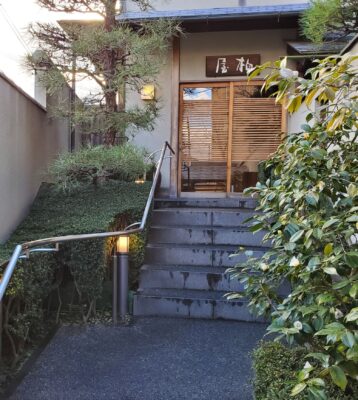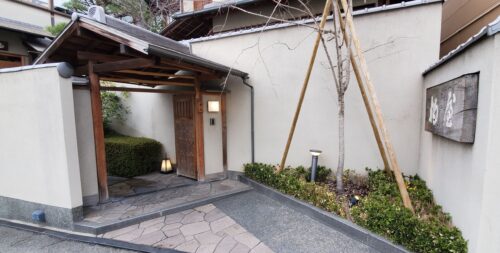
Kashiwaya
2-5-18 Senriyamanishi, Suita,
Osaka, 565-0851, Japan
+81 6-6386-2234
Official Site
As the third most populous city in Japan with over 2 million inhabitants, Osaka is widely known as the kitchen of Japan, a title bestowed upon the city during the Edo period. It boasts a diverse gastronomic landscape offering various cuisines at different price points. In fact, Osaka has the fourth highest concentration of Michelin-starred restaurants on Earth, surpassing other culinary centers such as Hong Kong, London, and New York. However, it is often overshadowed by Japan’s more famous cities like Tokyo and Kyoto. Among the notable establishments in Osaka is Kashiwaya, one of the city’s three Michelin-starred restaurants.
Kashiwaya has been a family-operated restaurant since 1977 and is currently under the ownership of Chef Hideaki Matsuo , the son of the original owner. Chef Matsuo assumed the role of master chef in 1993, and under his guidance, Kashiwaya garnered two stars in the first Michelin guide in 2009 for the Kansai region. The coveted third star followed a year later in 2010, a distinction it has proudly maintained ever since. Additionally, Kashiwaya holds the Michelin Green Star award and is a distinguished member of the prestigious Relais & Châteaux hotel and restaurant group.
The restaurant is situated in the Suita district outside Osaka’s city center, and taking a taxi is the most convenient and recommended mode of transportation to reach it. Kashiwaya’s unassuming facade seamlessly blends with the other houses on the street, making it easy to overlook. Upon entering the gates, guests are greeted by a serene Japanese garden, setting a tranquil atmosphere. A gracious hostess, dressed in a traditional kimono, warmly welcomes me and guides me through a sliding door to my washitsu, or Japanese traditional room. I immediately feel a sense of privacy as I have the room all to myself. The room is furnished with a short table, a back-supporting cushion, and floors covered in thick tatami mats where I had to sit during the duration of this meal.
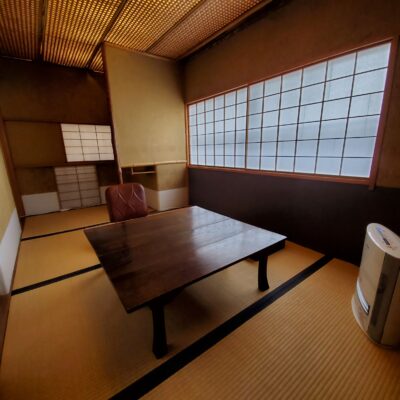
There are multiple kaiseki options offered at the restaurant, but on this visit, I opted for the “Ran” menu. Before starting the kaiseki, a delightful plum tea was presented, awakening the palate. This was immediately followed by the first course of Sakizuke – spot prawn, sea urchin,canola flower with butterbur paste, yam, carrot and radish, wasabi. This dish exuded a pleasant oceanic essence, with the prawns offering a beautiful sweetness. The spicy bitterness supplied by the radish and wasabi helped create a well-balanced dish.
“Ran”:
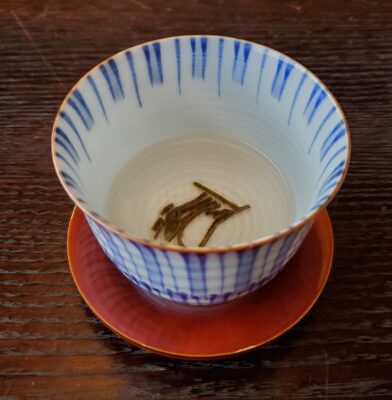
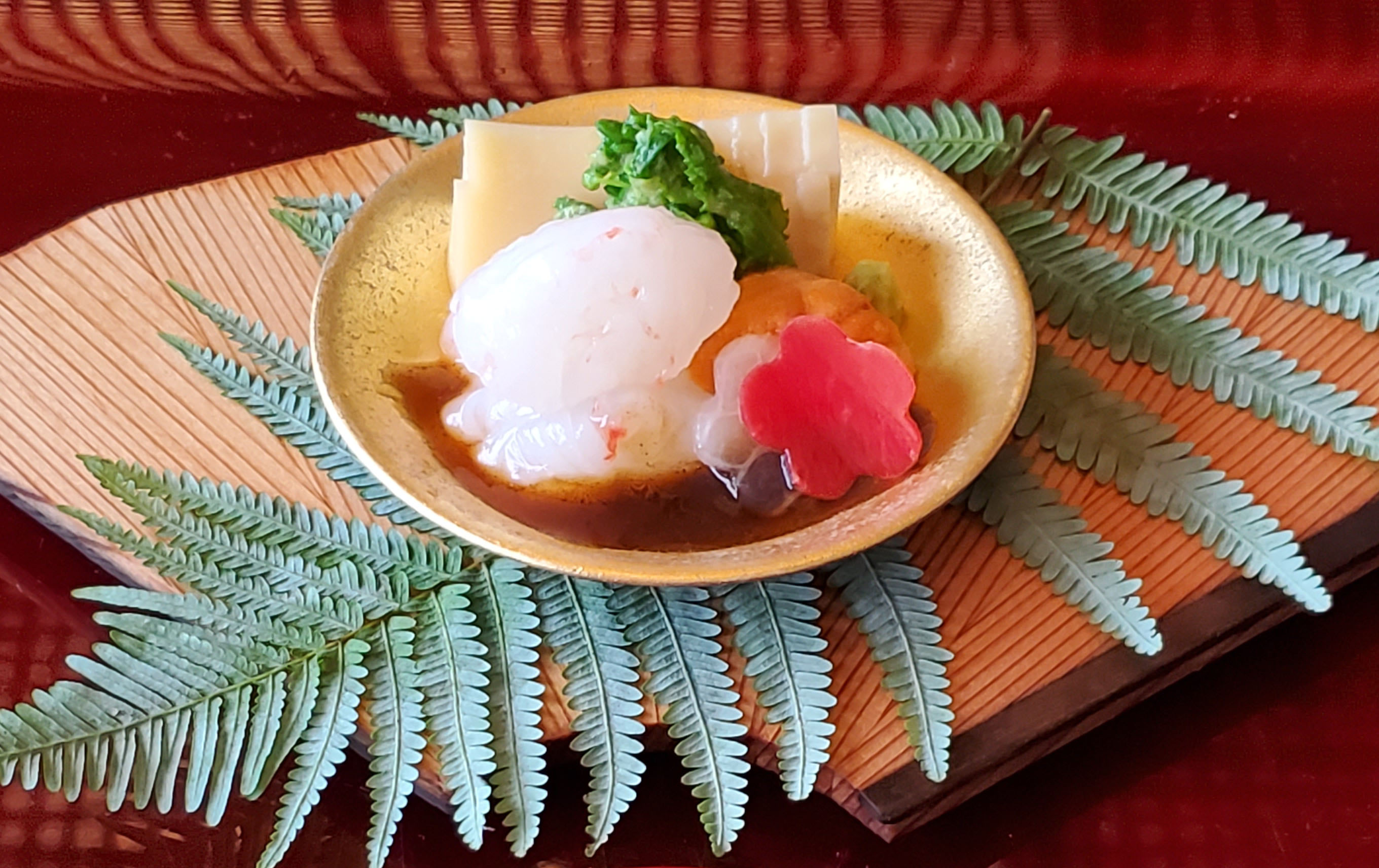
Kae – mackarel sushi rolled in turnip, salmon roe was the next. The raw turnip was crunchy, and its mild spiciness was perfect with the mackerel’s fatty features. Meanwhile, the side of salmon roe provided a wonderful saltiness to the dish, especially when eaten together. Then came the Nimonowa – Ise lobster, shiitake mushroom, turnip, jinbasou, syungiku, yuzu. This bowl of soup was infused with robust lobster flavors, accompanied by pleasant earthy notes. The lobster meat, mushrooms, and other vegetables wonderfully absorbed the flavor-packed broth.
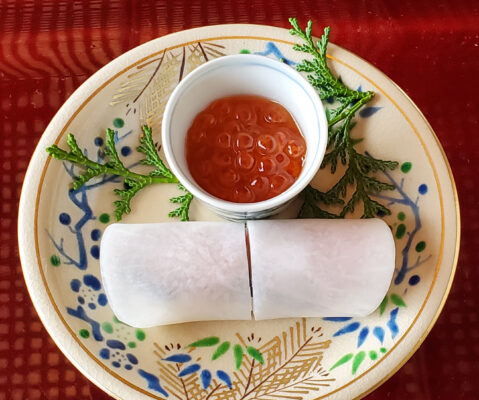
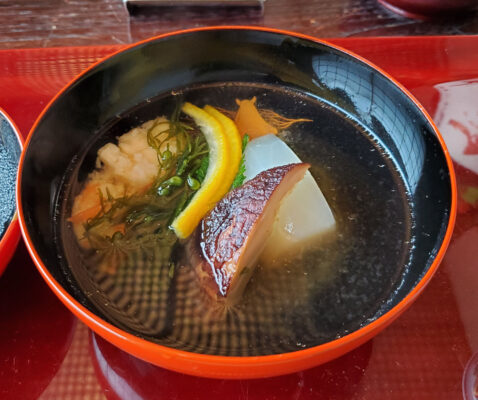
On to the sashimi course of Otsukuri – Long tooth grouper, tuna, Miru clam, bofu, carrot and radish, red tade, wasabi, two soy sauces (mixed with kelp and sudachi juice). The sashimis were fresh and clean tasting. They were served with two kinds of soy sauce, each imparting a different type of saltiness to the sashimis, both of which were equally terrific. That was followed by the Kan – Matsuba crab, blowfish milt, mitsuba with Yoshino kazu starch soup in yuzu cup. Presented within a whole yuzu, this wonderful dish features a thick starchy texture combined with flavorful crab meat and the intriguing salty creaminess of the blowfish milt. Following instructions, I squeezed the yuzu cover, revealing another dimension to the dish.
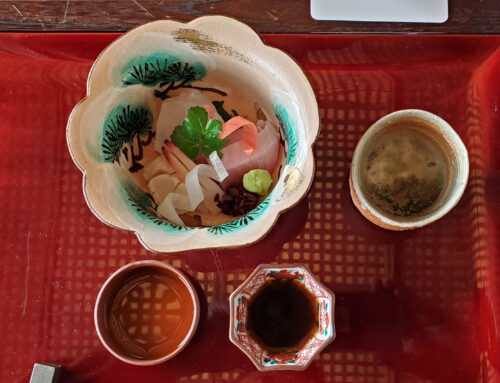
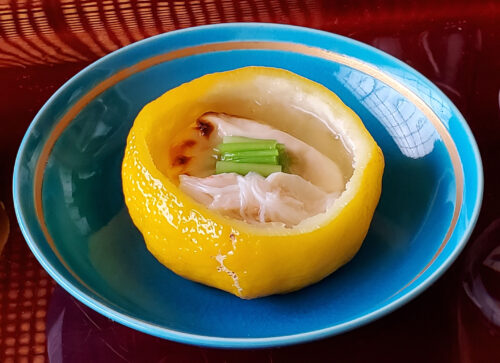
Hassun – Egg yolk sushi (salmon, halfbeak, cucumber), abalone, karasumi and radish, black bean jelly, tara sprout, Shirae (soba see, white cloud mushroom, lotus root, ginkgo, pine nut mixed with tofu paste) – Udo, ricotta cheese, stem lettuce skewered on pine needle was served on two small plates. One plate featured egg yolk sushi wrapped in salmon, halfbeak, and cucumber, offering interesting blends of eggy sweetness, a touch of sourness, and the freshness of the fish. Additionally, thick pieces of superb abalone and sweet black bean jelly adorned this plate. The other plate held a tofu salad with very good earthy notes
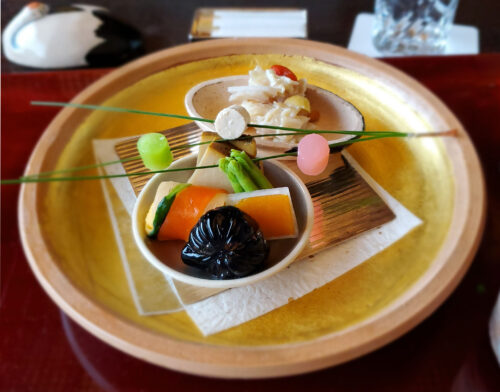
The Yakimono – Tilefish grilled with misoyuan sauce, hataken with mustard was grilled elegantly. The fish was delicate, and the skin was extra crispy. Its sharp salinity was perfectly balanced by the bitterness of the mustard leaf. Next came the Hachi – Densuke conger eel, ebiimo (taro), spinach, tachibana pepper. The eel was prepared masterfully, so delicate it melted like cotton candy in the mouth, and it was extremely delicious. The dashi kombu broth produced an umami taste that elevated the eel to another level. Gohan Shiru – Steamed rice mixed with butterbur, Japanese pepper leaf, saikyo miso soup (shiokujira, radish, white leak, mustard) was the final savory course of this kaiseki. The steamed rice emitted beautiful vegetal aromas, and the miso soup, containing salted whale meat, was uniquely tasty.
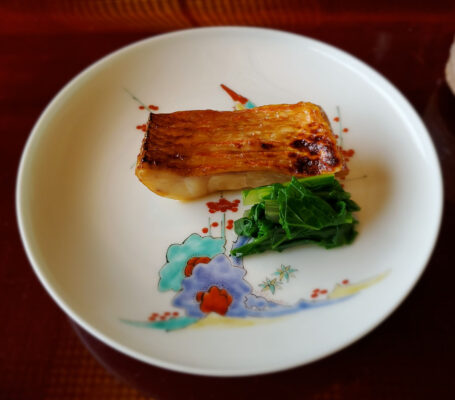
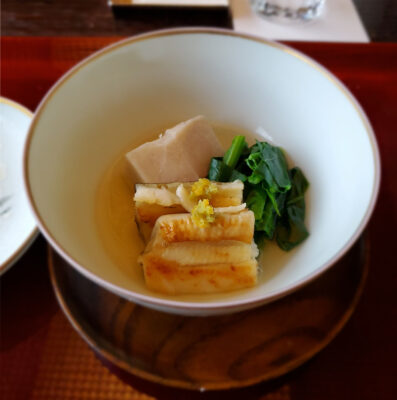
Transitioning over to the sweet courses, I was served the Mizumono – Hassaku and strawberry, which featured Hassaku, a citrus from Japan, and Japanese strawberries. These fruits were truly exceptional, incredibly fresh and vibrant. To conclude the meal, I enjoyed the Kashi – Akebono kinton, which had a grainy texture with a subtle sweetness that I found enjoyable. It was accompanied by matcha tea that was creamier and different from what I’ve had before.
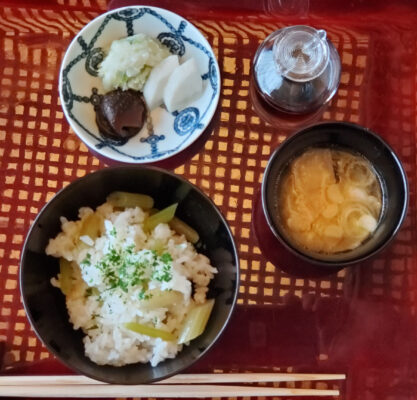
Kashiwaya’s seafood-centric kaiseki was excellent, showcasing cooking at the highest level and an unparalleled attention to detail. The cuisine was characterized by simplicity, yet it boasted beautiful flavors that were both light and subtle. Chef Matsuo meticulously sources the finest, in-season ingredients, allowing him to utilize them at their absolute peak.
Opting for the sommelier-recommended sake pairing with this kaiseki was indeed a wise choice. The selection comprised ten premium brands of sake from various regions of Japan. Each sake, with its distinct characteristics, impeccably enhanced the flavors of each course. The sommelier’s choices were spot on and added an extra layer of enjoyment to the dining experience.
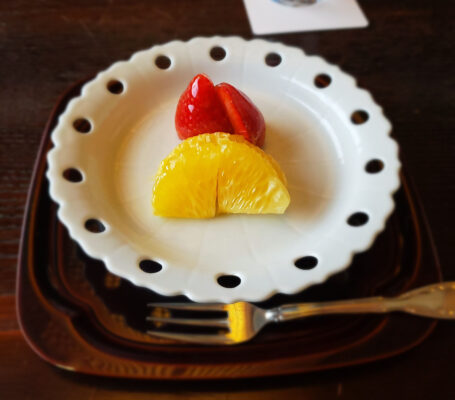
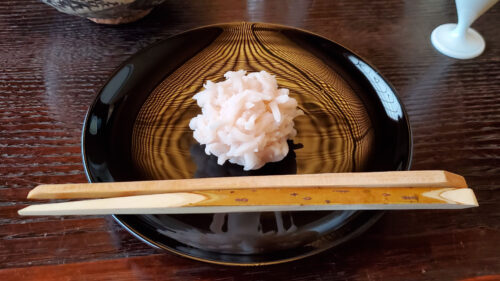
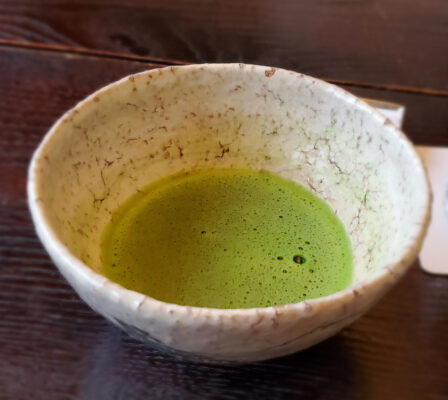
The service was exceptional. The female servers, dressed in impeccably arranged kimonos, were highly respectful and communicated fluently in English, likely due to the significant number of foreign diners visiting. They were unobtrusive, displaying a keen sense of privacy by knowing precisely when to clear empty plates or refill glasses of water, appearing inside the room seamlessly. At the end of the meal, Chef Matsuo graciously made an appearance to express gratitude for my visit and ensure my safe departure in a taxi. Japanese hospitality was truly on display that evening.
Sake Pairing:
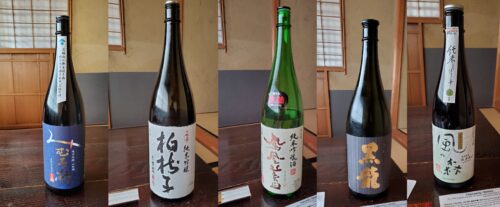
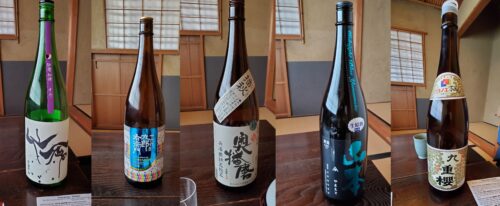
There are multiple kaiseki options offered at different price points at Kashiwaya, making it accessible to many. While those with deeper pockets can indulge in an option that showcases more premium ingredients at a higher price point, the “Ran” option that I had was more than enough to experience how wonderful this restaurant is at a fair price.
In Osaka, where there is an abundance of dining choices, Kashiwaya stands out as the restaurant to visit for traditional kaiseki dining at the highest level. This three Michelin-starred establishment delivers an impeccable dining experience.

